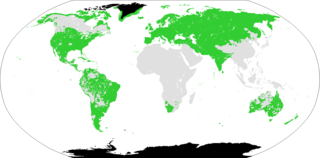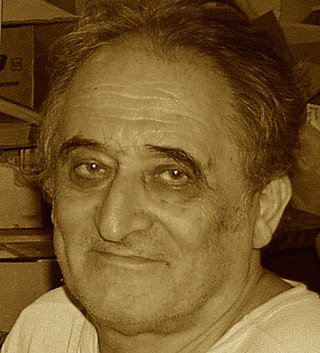Related Research Articles

Altaic is a controversial proposed language family that would include the Turkic, Mongolic and Tungusic language families and possibly also the Japonic and Koreanic languages. Speakers of these languages are currently scattered over most of Asia north of 35° N and in some eastern parts of Europe, extending in longitude from Turkey to Japan. The group is named after the Altai mountain range in the center of Asia. The hypothetical language family has long been rejected by most comparative linguists, although it continues to be supported by a small but stable scholarly minority. The research on their supposedly common linguistics origin has inspired various comparative studies on the folklore and mythology among the Turks, Proto-Mongols and Tungus people.

Nostratic is a controversial hypothetical macrofamily, which includes many of the indigenous language families of Eurasia, although its exact composition and structure vary among proponents. It typically comprises Kartvelian, Indo-European and Uralic languages; some languages from the similarly controversial disputed Altaic family; the Afroasiatic languages spoken in North Africa, the Horn of Africa, the Arabian Peninsula and the Near East as well as the Dravidian languages of the Indian Subcontinent.
Glottochronology is the part of lexicostatistics which involves comparative linguistics and deals with the chronological relationship between languages.
Lexicostatistics is a method of comparative linguistics that involves comparing the percentage of lexical cognates between languages to determine their relationship. Lexicostatistics is related to the comparative method but does not reconstruct a proto-language. It is to be distinguished from glottochronology, which attempts to use lexicostatistical methods to estimate the length of time since two or more languages diverged from a common earlier proto-language. This is merely one application of lexicostatistics, however; other applications of it may not share the assumption of a constant rate of change for basic lexical items.
Mass comparison is a method developed by Joseph Greenberg to determine the level of genetic relatedness between languages. It is now usually called multilateral comparison. The method is rejected by most linguists, though not all.
Comparative linguistics, or comparative-historical linguistics is a branch of historical linguistics that is concerned with comparing languages to establish their historical relatedness.
The Swadesh list is a classic compilation of tentatively universal concepts for the purposes of lexicostatistics. Translations of the Swadesh list into a set of languages allow researchers to quantify the interrelatedness of those languages. The Swadesh list is named after linguist Morris Swadesh. It is used in lexicostatistics and glottochronology. Because there are several different lists, some authors also refer to "Swadesh lists".

Eurasiatic is a proposed language macrofamily that would include many language families historically spoken in northern, western, and southern Eurasia.

Indo-Uralic is a controversial hypothetical language family consisting of Indo-European and Uralic.
In linguistics, a polarity item is a lexical item that is associated with affirmation or negation. An affirmation is a positive polarity item, abbreviated PPI or AFF. A negation is a negative polarity item, abbreviated NPI or NEG.

Aharon Dolgopolsky, also spelled Aron was a Russian-Israeli linguist who is known as one of the modern founders of comparative Nostratic linguistics.
In linguistics, the term lexis designates the complete set of all possible words in a language, or a particular subset of words that are grouped by some specific linguistic criteria. For example, the general term English lexis refers to all words of the English language, while more specific term English religious lexis refers to a particular subset within English lexis, encompassing only words that are semantically related to the religious sphere of life.
Paleolinguistics is a term used by some linguists for the study of the distant human past by linguistic means. For most historical linguists there is no separate field of paleolinguistics. Those who use the term are generally advocates of hypotheses not generally accepted by mainstream historical linguists, a group colloquially referred to as "long-rangers".

The Madang or Madang–Adelbert Range languages are a language family of Papua New Guinea. They were classified as a branch of Trans–New Guinea by Stephen Wurm, followed by Malcolm Ross. William A. Foley concurs that it is "highly likely" that the Madang languages are part of TNG, although the pronouns, the usual basis for classification in TNG, have been "replaced" in Madang. Timothy Usher finds that Madang is closest to the Upper Yuat River languages and other families to its west, but does not for now address whether this larger group forms part of the TNG family.
Linguistics is the scientific study of human language. It is called a scientific study because it entails a comprehensive, systematic, objective, and precise analysis of all aspects of language, particularly its nature and structure. Linguistics is concerned with both the cognitive and social aspects of language. It is considered a scientific field as well as an academic discipline; it has been classified as a social science, natural science, cognitive science, or part of the humanities.
The Soviet Union actively tried to incorporate Marxist ideals into the study of linguistics.
The Leipzig–Jakarta list of 100 words is used by linguists to test the degree of chronological separation of languages by comparing words that are resistant to borrowing. The Leipzig–Jakarta list became available in 2009.
The Automated Similarity Judgment Program (ASJP) is a collaborative project applying computational approaches to comparative linguistics using a database of word lists. The database is open access and consists of 40-item basic-vocabulary lists for well over half of the world's languages. It is continuously being expanded. In addition to isolates and languages of demonstrated genealogical groups, the database includes pidgins, creoles, mixed languages, and constructed languages. Words of the database are transcribed into a simplified standard orthography (ASJPcode). The database has been used to estimate dates at which language families have diverged into daughter languages by a method related to but still different from glottochronology, to determine the homeland (Urheimat) of a proto-language, to investigate sound symbolism, to evaluate different phylogenetic methods, and several other purposes.
The Moscow School of Comparative Linguistics is a school of linguistics based in Moscow, Russia that is known for its work in long-range comparative linguistics. Formerly based at Moscow State University, it is currently centered at the RSUH Institute of Linguistics, and also the Institute of Linguistics of the Russian Academy of Sciences in Moscow, Russia.
The Evolution of Human Languages (EHL) project is a historical-comparative linguistics research project hosted by the Santa Fe Institute. It aims to provide a detailed genealogical classification of the world's languages.
References
- ↑ Dolgopolsky, Aharon B. 1964. Gipoteza drevnejšego rodstva jazykovych semej Severnoj Evrazii s verojatnostej točky zrenija [A probabilistic hypothesis concerning the oldest relationships among the language families of Northern Eurasia]. Voprosy Jazykoznanija 2: 53-63.
- Trask, Robert Lawrence (2000). The dictionary of historical and comparative linguistics. p. 96.